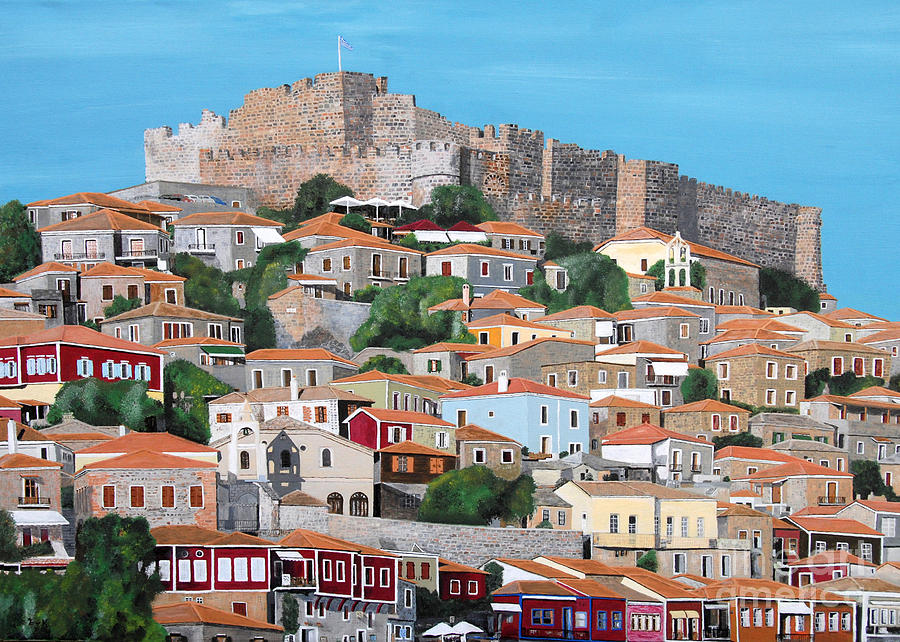
Lesvos (alternatively spelt Lesbos), the third largest of the Greek islands, is a little different from the rest, being largely self-sufficient thanks to its commerce in olive-growing and fishing. Despite being a popular summer holiday destination it remains unspoilt and natural, untainted by most tourist trappings, and its size precludes it from becoming overcrowded or claustrophobic like some of the other Greek resort islands.
Situated in the Aegean, Lesvos is very close to the Turkish coast and well connected by air and sea to Athens and Thessalonika, as well as some of the other Ionian Islands like Rhodes and Kos. The delightful island is encircled with quaint fishing villages and pale gold sandy beaches, while inland the fertile soil is rich with olive groves, the uplands covered in pine and holme oak. Two gulfs, which penetrate deep into the interior of the island, provide for an interesting, sheltered coastline. The main town on the island is Mitilini, a city of 30,000 inhabitants clustered around its well-preserved Byzantine castle. The favourite spots for holidaymakers, however, are the northern village of Molivos; the south coast town of Plomari (where it is reputed the finest ouzo in the world is still made); and Sigri, at the western tip, near the world's largest petrified forest. Apart from beautiful, secluded beaches and superb opportunities for walking and bird-watching, Lesvos has relics of a long and proud history to explore. The island has been inhabited since the Bronze Age, and rose to glory particularly around the 6th century BC when it was rivalled only by Athens as a great centre of civilisation, home to the legendary poets Sappho and Alcaeus. Lesvos is known as the birthplace of the ancient poet Sappho, and in recent years tourism has increased for lesbian and all-female tour groups who come to pay homage. Lesvos is known as a lesbian-friendly island, and resorts like Skala Eressos are focused on women-only holidays. Today it is easy for visitors to wax poetical when enjoying the serenity of this beautiful lush island with its balmy Mediterranean climate.
Resorts
See our separate guides to the following Lesvos holiday resorts: Molyvos
Attractions

Donkey trekking
Donkey trekking is a great activity for the whole family to enjoy together and even the little ones will be thrilled to ride on the gentle animals. Day-treks from Molios to Vafios are available, travelling through verdant green valleys, past olive groves and along mountain paths to the village of Vafios. Sunset-treks to Eftalou are also wonderful and upon arrival riders are rewarded with a tasty barbeque on the beach, drinks, and even a swim while the sun sets over the sea. Donkey treks are a great way to get to know the region and to appreciate the scenery and learn something about the local traditions as well as landscape. Lesvos is a self-sufficient, proud island with well-preserved local traditions and a refreshing lack of tourist trappings, despite its popularity with visitors. You will be accompanied by a guide and the trips are safe, relaxed and fun. Booking is recommended to avoid disappointment. It is also a good idea to check the weather before planning a trek.
Eftalou Thermal Baths
A trip to the Eftalou Thermal Baths is a wonderful excursion for anyone on holiday in Lesvos. The hot, natural springs are located nearly three miles (4km) outside of Molyvos on the northern coast of Lesvos. Highly popular with tourists, the Eftalou's Springs are located at the beach and are one of the few springs in Greece where men and women can bathe together. The temperature of the water is between 109 and 116°F (43 - 47°C), which is very hot. Bathing in the water is recommended for a number of conditions and illnesses including blood pressure problems, rheumatism, gallstones, and neuralgia. It is also just extremely relaxing and therapeutic! It is recommended, though, that you don't stay in the water for longer than 20 minutes in each session due to the extreme heat. There is an old, domed bath house, which has a charming, old-fashioned atmosphere and is an experience in itself, and a newly renovated spa building next door to it which offers a variety of treatments and facilities. The coastal setting is also pretty and enjoyable which adds to the experience. A novelty for children, this is an activity the whole family will enjoy.
Petrified Forest of Sigri
One of the two largest petrified forests in the world, the Petrified Forest of Sigri on the western edge of the island, dates back 15 million years and is protected as a natural monument. A visit to the Petrified Forest of Sigri is a fascinating outing for families with children or for anybody interested in natural phenomena. The Petrified Forest was the result of a volcanic eruption around 21 to 15 million years ago which buried the flora and trees of the region - including oaks and sequoias - beneath layers of ash. Visitors can view 'the Pompeii of the plant world' which features some impressively well-preserved specimens; on some of the trees you can still see leaves and fruit preserved for millennia. Visitors can view the Petrified Forest along three main mountain trails: Trail One is called 'Discovering the Petrified Forest' and is a good introduction to the area; Trail Two, 'The History of the Petrified Coniferous Forest', details the process by which the trees were preserved; and Trail Three, which is the longest, takes people to the tallest standing trunks. In Sigri there is an interesting museum dedicated to the forest which displays some stunning examples of petrified wood and explains the process well. |
No comments:
Post a Comment